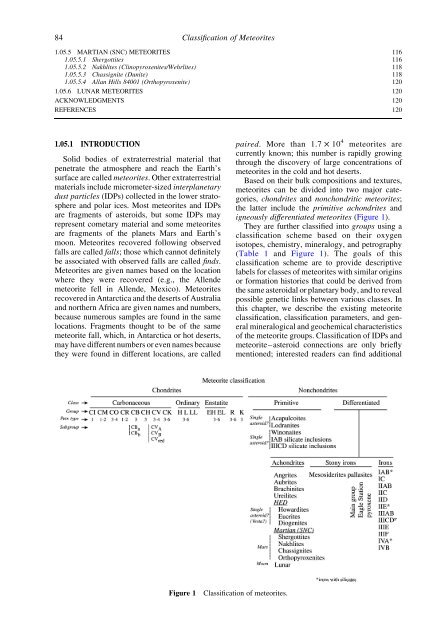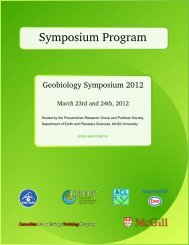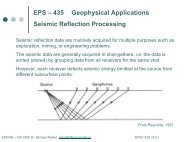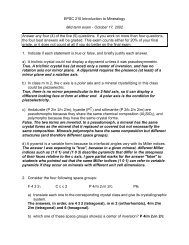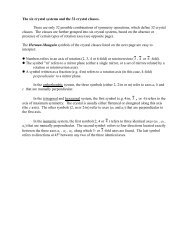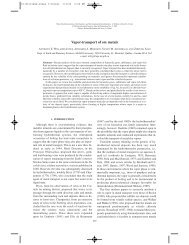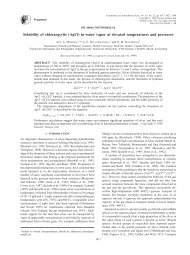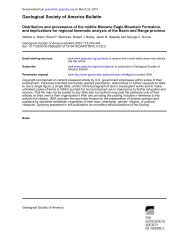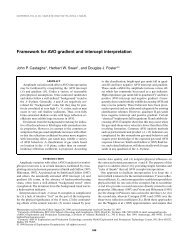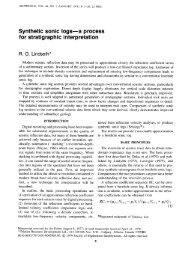05 Classification of.. - Department of Earth and Planetary Sciences
05 Classification of.. - Department of Earth and Planetary Sciences
05 Classification of.. - Department of Earth and Planetary Sciences
Create successful ePaper yourself
Turn your PDF publications into a flip-book with our unique Google optimized e-Paper software.
84<br />
<strong>Classification</strong> <strong>of</strong> Meteorites<br />
1.<strong>05</strong>.5 MARTIAN (SNC) METEORITES 116<br />
1.<strong>05</strong>.5.1 Shergottites 116<br />
1.<strong>05</strong>.5.2 Nakhlites (Clinopyroxenites/Wehrlites) 118<br />
1.<strong>05</strong>.5.3 Chassignite (Dunite) 118<br />
1.<strong>05</strong>.5.4 Allan Hills 84001 (Orthopyroxenite) 120<br />
1.<strong>05</strong>.6 LUNAR METEORITES 120<br />
ACKNOWLEDGMENTS 120<br />
REFERENCES 120<br />
1.<strong>05</strong>.1 INTRODUCTION<br />
Solid bodies <strong>of</strong> extraterrestrial material that<br />
penetrate the atmosphere <strong>and</strong> reach the <strong>Earth</strong>’s<br />
surface are called meteorites. Other extraterrestrial<br />
materials include micrometer-sized interplanetary<br />
dust particles (IDPs) collected in the lower stratosphere<br />
<strong>and</strong> polar ices. Most meteorites <strong>and</strong> IDPs<br />
are fragments <strong>of</strong> asteroids, but some IDPs may<br />
represent cometary material <strong>and</strong> some meteorites<br />
are fragments <strong>of</strong> the planets Mars <strong>and</strong> <strong>Earth</strong>’s<br />
moon. Meteorites recovered following observed<br />
falls are called falls; those which cannot definitely<br />
be associated with observed falls are called finds.<br />
Meteorites are given names based on the location<br />
where they were recovered (e.g., the Allende<br />
meteorite fell in Allende, Mexico). Meteorites<br />
recovered in Antarctica <strong>and</strong> the deserts <strong>of</strong> Australia<br />
<strong>and</strong> northern Africa are given names <strong>and</strong> numbers,<br />
because numerous samples are found in the same<br />
locations. Fragments thought to be <strong>of</strong> the same<br />
meteorite fall, which, in Antarctica or hot deserts,<br />
may have different numbers or even names because<br />
they were found in different locations, are called<br />
paired. More than 1.7 £ 10 4 meteorites are<br />
currently known; this number is rapidly growing<br />
through the discovery <strong>of</strong> large concentrations <strong>of</strong><br />
meteorites in the cold <strong>and</strong> hot deserts.<br />
Based on their bulk compositions <strong>and</strong> textures,<br />
meteorites can be divided into two major categories,<br />
chondrites <strong>and</strong> nonchondritic meteorites;<br />
the latter include the primitive achondrites <strong>and</strong><br />
igneously differentiated meteorites (Figure 1).<br />
They are further classified into groups using a<br />
classification scheme based on their oxygen<br />
isotopes, chemistry, mineralogy, <strong>and</strong> petrography<br />
(Table 1 <strong>and</strong> Figure 1). The goals <strong>of</strong> this<br />
classification scheme are to provide descriptive<br />
labels for classes <strong>of</strong> meteorites with similar origins<br />
or formation histories that could be derived from<br />
the same asteroidal or planetary body, <strong>and</strong> to reveal<br />
possible genetic links between various classes. In<br />
this chapter, we describe the existing meteorite<br />
classification, classification parameters, <strong>and</strong> general<br />
mineralogical <strong>and</strong> geochemical characteristics<br />
<strong>of</strong> the meteorite groups. <strong>Classification</strong> <strong>of</strong> IDPs <strong>and</strong><br />
meteorite–asteroid connections are only briefly<br />
mentioned; interested readers can find additional<br />
Figure 1<br />
<strong>Classification</strong> <strong>of</strong> meteorites.


